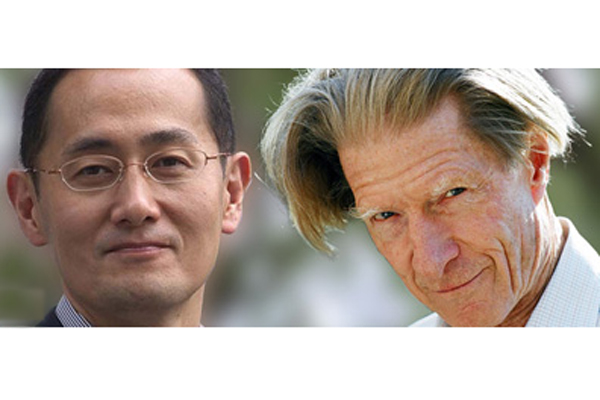Two Scientists Share Nobel Prize for Stem Cell Discoveries

(ISNS) -- The 2012 Nobel Prize in physiology or medicine has been jointly awarded to Japanese physician and adult stem cell researcher Shinya Yamanaka and British developmental biologist Sir John B. Gurdon "for discovering that mature cells can be reprogrammed to become pluripotent" - or capable of giving rise to several different cell types.
Their work has had huge ramifications in everything from the politics of sexual reproduction to the promise of regenerating brain or heart cells from other parts of the body to cure diseases and for cloning.
Gurdon, educated at Oxford, Cambridge and the California Institute of Technology, now runs his own institute at Cambridge, about 50 miles north of London. He made the prize-winning discovery 50 years ago, in 1962.
All animals, including humans, first begin as fertilized eggs, and the early embryo consists of undefined stem cells that contain all the basic information cells require in order for them to mature into particular body parts such as muscles, brain cells, and other organs. The text books all said that was a one-way trip: the cells grew from pluripotent to specialized cells. Gurdon proved that was wrong.
For his doctoral thesis at Oxford, Gurdon took the nucleus of cells from the intestines of one frog and transplanted the genetic matter into the fertilized egg of another. The egg grew into a normal tadpole. Gurdon had cloned a frog.
More importantly, he showed that the instructions contained within pluripotent stem cells are also contained within the specialized adult cells. The potential does not dissipate just because the cells grow up.
His work was met with considerable skepticism, not the least because all the text books had to be thrown out.
Sign up for the Live Science daily newsletter now
Get the world’s most fascinating discoveries delivered straight to your inbox.
"So it's entirely reasonable for the skeptics to say, well these well-established people have already done this experiment and here’s a graduate student from Europe who is disagreeing with them, why should we pay attention to that?" Gurdon said in an interview posted on the Nobel website.
Six years ago the 50-year-old Yamanaka, now at Kyoto University in Japan and the David Gladstone Institute at the University of California, San Francisco, did the same thing with mice and later human cells in the laboratory. Yamanaka began by looking for the genes that kept the early stem cells immature. He found a recipe of four genes from skin cells, injected them into cells that form connective tissue - fibroblasts - and turned them back in time to become pluripotent.
He said other scientists in Japan warned him against continuing the research because there did not seem to be any immediate practical use for the discovery and that he was endangering his career.
There also was skepticism because he announced his discovery shortly after a Korean scientist fraudulently claimed to have cloned a human. But his work was so simple it was immediately reproduced in other laboratories.
"He is very bright and very innovative and thinks out of the box," said Linzhao Cheng, a hematologist and cell researcher at Johns Hopkins who knows him. "He is not a traditional cell biologist."
The potential is enormous and controversial. One political aspect is that using Yamanaka's technique, scientists studying such diseases as Parkinson's disease or diabetes can create stem cells for research and perhaps therapy without destroying human embryos, eliminating some of the moral objections to stem cell research by those opposed to abortions or the disposal of unused embryos in in-vitro fertilization.
Moreover, it seems possible to take cells from one part of the body -skin for instance - and turn them back in time to embryonic cells and then induce them into becoming something else, for instance healthy heart or brain cells.
If the cells came from the same patient, there would be no threat of rejection. The cells produced in this way are called induced pluripotent stem cells, or IPS. Various types of IPS cells are now being produced and studied in laboratories around the world. Human trials are expected to begin next year, beginning with eye diseases, Yamanaka said.
Despite switching course in his career after beginning as a surgeon, Yamanaka still feels connected to working with patients.
"I still feel that I am a doctor, I am a physician, so I really want to help patients," Yamanaka said in an interview posted on the Nobel Prize website. "So my goal, all my life, is to bring this technology, stem cell technology to the bedside, to patients, to clinics."
"We are now reversing aging in a test tube," said Cheng. "Now we can take a skin cell and go all the way back to the most primitive cell types."
More details are available on via the below resources:
- Inside Science Senior Science Writer and Editor Chris Gorski provides additional information on his Inside Science Currents blog post
- Announcement from Nobel Prize organization
- Official Website: Nobel Prize in Physiology or Medicine
Joel Shurkin is a freelance writer based in Baltimore. He was science editor of the Philadelphia Inquirer and was on a team that won a Pulitzer Prize for coverage of Three Mile Island.
Inside Science News Service is supported by the American Institute of Physics.









